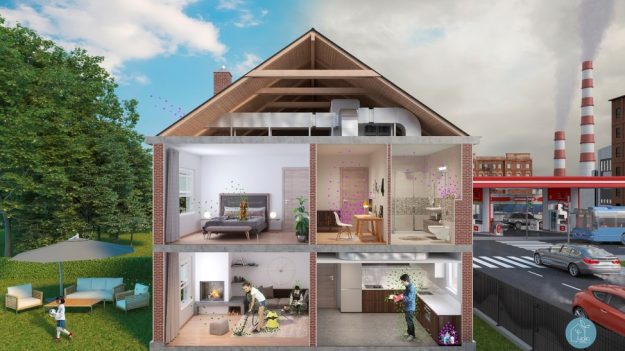TOWARDS IMPROVING ENVIRONMENTAL AIR QUALITY OF OCCUPANTS IN INDOOR SPACES THROUGH THE USE OF INTERMITTENT PERSONALIZED VENTILATOR AND UNDERSTANDING PARTICLE RESUSPENSION
The Human-Oriented Built Environment Lab (HOBEL) invites Douaa Al Assaad, PhD candidate specializing in Mechanical Engineering at the American University of Beirut, Lebanon, on 24 October 2019 at the Smart Living Lab in Fribourg.
The regulation of indoor air quality (IAQ) is crucial to protect occupants from possible contamination due to indoor pollutants, as it directly affects their health, well-being and productivity. Therefore, it is important to implement energy-efficient strategies that can improve the breathable air quality of occupants in indoor spaces; while simultaneously providing thermal comfort.
The first strategy was to assist conventional HVAC systems with intermittent dynamic personalized ventilation (PV) systems. The latter was coupled with mixing ventilation (MV), displacement ventilation (DV) and chilled ceiling (CC) systems in office spaces. Experimentally validated computational fluid dynamics (CFD) and mathematical models were used to study the performance of this system and compare it to a steady PV. It was found that intermittent PV enhanced thermal comfort especially in warm indoor conditions. However, due to its increased turbulence, it provided lower, but nonetheless satisfactory IAQ compared to steady PV, at optimal frequencies of 0.86 Hz, 0.5 Hz with MV, DV & CC respectively. Energy savings of 16.1%, 15.7% & 7.52% were also respectively achieved.
The second strategy was to understand the mechanisms governing particle resuspension and dispersion due to indoor human activities. This was investigated in the case of a human performing prostration in a mosque space. Through an experimentally validated CFD model, it was shown that the prostration cycle disturbed the flow field in the person’s microenvironment, increasing turbulence levels to 20%. The motion and established pressure gradients transported and dispersed particles from the floor to higher levels, contaminating the breathing zone throughout the motion.
Preventive measures will be adopted in future studies to minimize resuspension phenomena from floors. This includes developing mathematical resuspension models due to indoor human activities for better understanding of the physics governing the phenomena.
Invited Talk #7 Fribourg | 11:00-12:00
Kontakt
Ms. Douaa Al Assaad is a PhD candidate specializing in Mechanical engineering at the American University of Beirut, Lebanon. She received her Master’s Degree in Signal processing from Jean Monnet Saint-Etienne University and Ecole des mines de Saint-Etienne, France and her Bachelor’s degree in Mechanical Engineering from Lebanese University. Her research work revolves around implementing energy efficient strategies in indoor spaces to enhance thermal comfort and provide good indoor air quality (IAQ). She has worked on optimizing the performance of intermittent personalized ventilation (PV) systems coupled with conventional HVAC systems through CFD modeling and simplified mathematical modeling. Her work also involved investigating the impact of human prostration on particle dispersion in the indoor environment and its effect on IAQ. Currently, she is working on developing mathematical models to better understand the impact of aerodynamic and vibration disturbances generated by human activities on particle resuspension.
